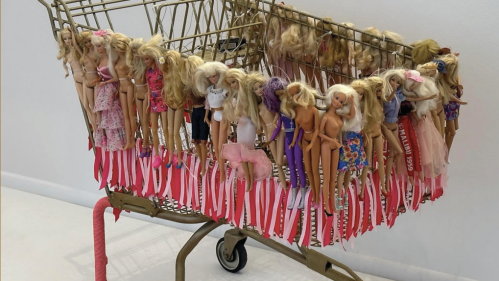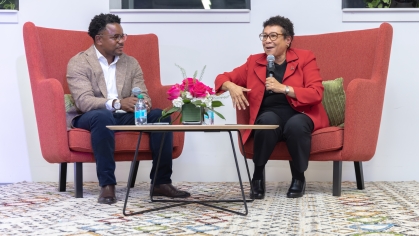Robeson Gallery Pairs Artifacts Unearthed through On-Campus Excavation with Works by Women of Color

Everyday objects that remained buried beneath the Rutgers-Newark campus, some for hundreds of years, serve as both artifact and inspiration for “Despite the Spoils,’’ an exhibition curated by artist Armisey Smith and featured at the Robeson Campus Center Gallery through October 26. The opening will be held September 14 from 5 p.m. to 7 p.m.
The artifacts were among 25,000 pieces excavated from a historic city block on the Rutgers-Newark campus bordered by Washington, Halsey, New and Linden Streets. It is now the site of the Honors Living-Learning Community.
Smith sifted through the collection to select groupings of objects and juxtapose them with original work from five contemporary women artists of color. Among the pieces she chose are porcelain doll parts, fragments of decaying leather and old apothecary bottles.
The contemporary art -- including works made from Barbie dolls, old fabric and vintage paper sewing patterns -- is positioned in dialogue with the excavated pieces, serving as commentary on time, durability, oppression, and European standards of beauty.
“This exhibition features artifacts based on uncovered remnants likely subject to complete decay but have survived despite environmental stressors,’’ said Smith. “The artists and artwork selected amplify the resilience of women under constant assault by external factors and political factions.”
“Despite the Spoils” is the first in an ongoing, multiyear series of exhibitions that will be drawn from the artifacts, each with a different curator, said Anonda Bell, director of the Robeson Gallery.
Bell describes “Despite the Spoils,’’ and other exhibitions planned for the series, as a “creative hybrid” between historical display and art that draws connections between Newark’s past and present. The series is called “Invisible Cities,” after the novel by Italio Calvino.
“It suggests that we might consider the possibility of plural histories of a city, and that there are many histories of any city that have remained hidden from us,’’ said Bell. “It will bring to light new knowledge about the city of Newark, and tell many stories about this place.”
The neighborhood that was excavated included the Halsey Street Methodist Episcopal Church and cemetery, which existed from the mid-1800s until the 1920s, when the site was no longer used.
During the excavation, 300 sets of human remains were exhumed and re-interred at a cemetery in Union, despite efforts by the church at the time of its move to identify all remains that needed to be re-interred. Some of the decaying material on display may be coffin linings or funeral decorations, although items that were definitively confirmed as part of burial rites were interred, said Bell.
Also at the excavation site was a doctor’s office, which seems to account for the apothecary containers on display, and private homes. For many years, before a system of municipal garbage collection was developed, it was common for residents to bury discarded objects on their property.
Smith was especially struck by remnants of shoe leather and cloth that were found, severely decayed after centuries underground but still existent. These are on display in one of three glass cases that hold the exhibition’s artifacts.
“I was fascinated by the organic materials and that’s why I reclaimed them,’’ she said. “For even a small amount to survive was incredible to me.”
For Smith, they serve as a metaphor for the survival of African Americans, particularly women, who endured the brutality of slavery and the intermingling of European ancestry, often as a consequence of rape.
“Despite history, phenotype, and how we arrived here in the Americas, we were still able to survive and emerge from the spoils and the movement of humanity over time. And we’re still here,’’ she said. “I thought of what these objects represented about personhood and womanhood and what it means to be a woman artist of color today.’’
Among the contemporary works in “Despite the Spoils” is artist Theda Sandiford’s assemblage of blonde Barbies tied to a golden shopping cart with pink ribbon. Titled “Where’s Malibu Barbie?” it serves as an ironic response to the doll parts on display, raising questions about beauty standards represented by Barbie and how they harm women of color.
“It’s juxtaposed with dolls that represent a Eurocentric vision of femininity, how it can activate microaggressions and harmful racial messages,’’ said Smith.
Some of the artifacts -- rusted old clock pieces -- are encased in glass beside a mural that Smith created last year at the entrance of the Robeson Gallery. Called a “Question of Time,’’ it depicts a blue-eyed Black woman and the fragmented lines of a sundial, symbolizing the disruption of time for Black and brown people in the Americas, said Smith.
“Time was stolen from people of color through the trans-Atlantic slave trade, colonialism of the ancient Americas, and manifest destiny,’’ she said. “What would time have looked like if people of color were not displaced?”
Other artists featured in “Despite the Spoils” are Krystle Lemonia, whose tapestries embody the fragility of organic matter through fabric. Her pieces often focus on immigrant Black women performing domestic labor, whose contributions play an integral role in the function of society.
Artist Pam Cooper’s work is constructed of handmade abaca paper and found objects that address past and present social issues, including the removal of children of color for political reasons. These are symbolized by baby shoes fashioned from paper and tagged with notes referring to the children’s displacement or disappearance, such as the Aboriginal children of Australia, who were taken from their families in a state-sponsored effort to assimilate them into white society.
Monifa Kincaid’s illustrations, which combine figures of Black women with plants and flowers, stand as a reference to the organic material among the artifacts and highlight themes of personal growth and unhealthy perceptions of women’s bodies.
The artist Eleven uses fabric, feathers, paint and found objects to explore the subconscious and the impact of marginalized people’s displacement through figurative creations such as the Goddess of Wilderness and Big Spirit/Little Spirit.


